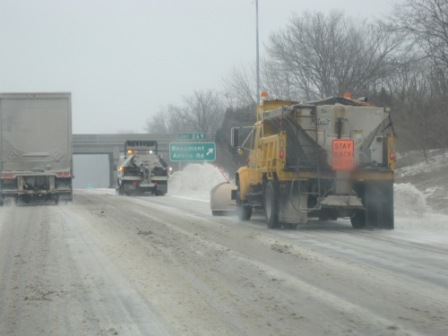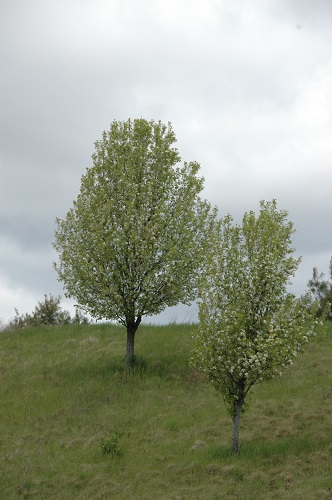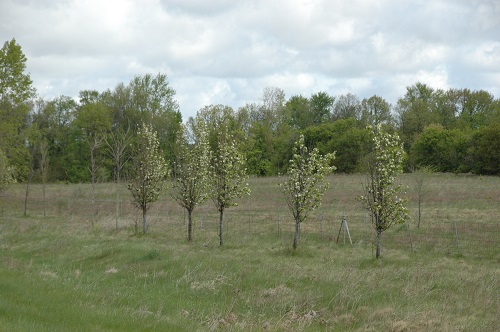Last week I posted about some horticultural disasters I witnessed in the Czech Republic. This week the chamber of horrors is little closer to home; virtually in my back yard to be specific. Our property backs up to US 127, the main North-South through route in our area. It’s a limited access highway with a posted speed of 70 mph, which means an average speed of 82.7 mph. It also means the road is regularly salted whenever it snows during the winter. As a result, some plants along the highway really take a beating, sometimes with some interesting results.

On Friday I received an email from Susan Gruber, our Undergraduate Advisor, who also commutes on US 127. “Hey Bert, Have you seen the pear trees on the east side of NB 127 just south of the Round Lake Road (and Price Rd) exits? Street side fried, shows up great with flowers on the other side. Also same trees planted at the same time doing great by the ramps, farther from the road, slower traffic, some up on the berms etc. Make great GP fodder, but I didn’t have a decent camera or the guts to pull over and do phone photos in rush hour.”

Unaffected pears upslope and away from salt exposure
Indeed I had seen the trees. As Susan noted, the sides of the trees facing the highway were fried, the opposite sides were in full bloom. I got a few photos over the weekend but the effect was a little less striking than earlier in the week when the trees had blooms but hadn’t begun the leaf out.

Pear trees in the line of fire
The planting illustrates a classic example of wrong tree-wrong place. Interestingly there are several crabapples that were installed as part of the same planting project that seem to be doing well. Selecting trees for exposure to deicing salt is a dicey proposition since, like this example, most of our information is anecdotal. Where the effects of deicing salt on plants have been systematically examined, the studies may focus on only soil exposure or only aerial deposition; whereas trees in the real world get it with both barrels.

Eastern white pine after one winter at a rest area along I-96 east of Lansing. An ideal proving ground for salt tolerant plants.
Ironically a colleague of mine in our department and I put together a proposal several years ago for our state Department of Transportation (MDOT) to identify salt tolerant plants for roadside plantings. Our plan was to install a series of replicated plantings of perennials (trees, shrubs, herbaceous perennials) at highway rest areas throughout the state. We would then correlate plant performance with degree salt exposure and identify plants that could survive, grow and maintain their aesthetic value under the highest salt loads. Initial discussions were positive until the proposal worked its way up the chain of command. Finally it was determined – I am not making this up – that MDOT could not participate in a project on indentifying plants that were tolerant of deicing salts because that means they would have to admit that salt was causing a problem. OK; just don’t tell the trees on US 127…

In our studies we rate plants on a scale of 1 (alive) to 5 (dead). These are class 4 (wish they were dead…)
My husband and I own several hundred feet of frontage on a county road. Lucky the vast majority of plantings are a good distance from the right of way but I do have some day lilies and oriental lilies right by the mailbox which are surviving quite nicely. Much of our frontage is on a steep slope hence no planting and hopefully it stops the salt from affecting the plant material. This is in NE Wisconsin. But what are your thoughts on the UP’s use of sand and its effects come spring vs the salt?
I remember driving from my parents house in Jackson to MSU via 127 looking at the sad, sad trees lining the highway. Sometimes you could see where the plows had sprayed the evergreens and burned them brown.
I don’t think about cars, I thinks about trees. If we plant more and more trees. Our planet will be safe.
Fascinating. And so sad about the almost funded study. Btw, isn’t there a ‘not’ missing in the phrase, “that MDOT could participate in a project”?
Karen S. thanks for catching the typo. That line lost a little zing as written…
Gail:
Sand should have relatively little impact on surrounding vegetation compared to sodium chloride. I don’t know how much sand is used in the UP or in WI. In lower Michigan the goal appears to be keeping roadways clear so salt is the weapon of choice. I know there are some efforts to reduce salt use; for example, pre-applying salt before a snow or ice event. Apparently it takes less salt to keep ice from forming that it does to melt it once it’s formed. Alternative de-icers are used for certain applications (e.g., reduce corrosion on bridges) but the high cost usually prohibits wider usage.
Those pictures illustrate ‘fried trees’ well. The MDOT’s stance on this is laughable …
… Plausible deniability is a beautiful thing.
How do you know it was salt induced? Could it also be that some of the trees are C3 plants and some are C4 plants? did anybody check the trees to check for pesticide residue since highways right of ways are sprayed?
Dave, the pesticide question is a good one, but all of the trees would be C-3 species. Let’s see what Bert has to say about the other possibilities.
Dave,
I drive this stretch of highway daily – the right of way gets mowed but I’m not aware that they apply any herbicides. Moreover, there are several species of trees along this stretch of road – none were as affected as the pears. If it were herbicide I would expect more damage across the board. Lastly, I have sampled trees several times in similar situations and found eleavted foliar chloride levels – often well above toxicity levels. I’ll grant it’s a circumstantial case but it’s a strong one. Someone would have to come up with some compelling evidence to convince me to the contrary.
Would like the name of the orange flower on roadside us127 north of Jackson,mi
Hi Leo:
Not sure of the exact location you’re talking about. Daylilies have naturalized along many roadsides in mid-Michigan. Check image here : http://www.flickr.com/photos/fireweaver/5003346928/